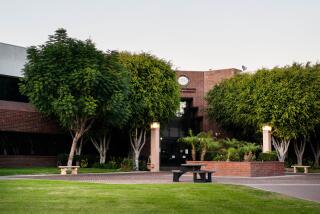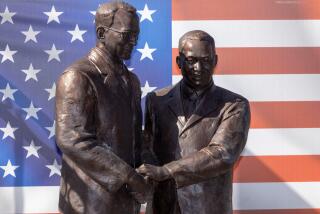Silver Lining
- Share via
Twenty-five years ago Thursday, an anxious group of Martin Luther King Jr./Drew Medical Center employees organized their operating rooms, sorted their syringes and then waited, praying that somebody--anybody--would come in and need them.
It was an interminably long hour and a half before anyone showed, the now-seasoned veterans recalled.
On Thursday, as they celebrated the 25th birthday of a hospital that rose from the rubble of the Watts riots, the facility’s original employees celebrated their own coming of age as well.
The first days were daunting, most of the employees recalled, with scant supplies, short public support and a host of naysayers awaiting any misstep.
But times now may be even tougher.
The facility has been forced to serve increasing numbers of people as public funding has dwindled. A series of medical mishaps and malfeasance by employees has further tarnished the overwhelmed hospital.
But through all its difficulties, a strong sense of purpose has guided King/Drew employees to continue helping an underserved, mostly poor, largely minority population with pride.
On March 27, 1972, at 9:30 a.m., William Thompson entered the first hospital to ever serve South-Central Los Angeles in search of medical attention. A team of overeager workers, in new, starched uniforms practically cheered.
“I think we gave that man every kind of service we could,” said Tessie Cleveland, the first head of social services and now the leader of that department and public relations.
“We were so happy--we later had 12 patients and the lab technicians ran their specimens 12 times.”
Before Thompson arrived, none of the employees wanted to acknowledge their biggest fear: that no one would show up.
The doctors, nurses, technicians and support staff practiced and prepared for months before they opened their doors, but still, rumors had been flying that no one would appear. Those in need, some predicted, would continue their long travels to Los Angeles County-USC Medical Center and other facilities rather than face the unknown and untested.
Every patient that walked through the door felt like a victory.
“They told us we weren’t going to last,” said Michael Taylor, 53, who started work 25 years ago as a maintenance department apprentice and now serves as a plant manager. “I think everyone here was trying to prove that wrong.”
Back in 1972, African Americans had trouble getting into skilled, union jobs. The networks and inroads to those types of apprenticeships, Taylor recalled, were effectively closed to him until King/Drew opened its doors across the street from his home.
Indeed, applications for unskilled and entry-level jobs poured in by the thousands practically from the day planning on the hospital began.
Filling skilled positions was harder, Cleveland said. Not too many doctors and nurses lived in South Los Angeles and most of those outside the area were afraid to come in.
For Brenda Taylor, 52, leaving her job as a registered nurse at Daniel Freeman Memorial Hospital to become a pediatric emergency nurse at King/Drew was a source of pride--and still is.
Just before opening day, she said, her department was still awaiting delivery on many supplies. So she and the other nurses chipped in, went to a local drugstore and bought the materials themselves.
“We did it because we wanted to make sure the patients in our community were provided care as good as other patients in other communities,” said Taylor, who met her husband, Michael, on the job at King/Drew. “We felt like we’d go that extra mile regardless of what it took.”
For its part, the community showed its gratitude.
On March 29, 1972, Dr. Ezra Davidson, chairman of the department of obstetrics and gynecology, delivered the hospital’s first baby. His mother named him Martin Ezra in honor of the facility and the doctor who brought him into the world.
Over the next few days, as word got out that the new hospital had a new baby, hundreds of neighbors came in to gaze upon their two miracles.
“I’m not sure I could completely explain it myself,” said Davidson, now 63 and retired. “It was a rather exhilarating moment.”
More to Read
Sign up for Essential California
The most important California stories and recommendations in your inbox every morning.
You may occasionally receive promotional content from the Los Angeles Times.













